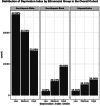Impact of APOE4-related dementia risk in underrepresented groups from the All of Us research program
- PMID: 40501118
- PMCID: PMC12159303
- DOI: 10.1002/alz.70245
Impact of APOE4-related dementia risk in underrepresented groups from the All of Us research program
Abstract
Introduction: Longitudinal electronic health records (EHRs), "dementia" diagnostic codes, and genetic data from All of Us were used to see if there is a higher risk of dementia and an attenuated impact of apolipoprotein ε4 (APOE4) on Alzheimer's disease (AD) risk in Black and Hispanic/Latino groups.
Methods: Participants included 9,784 Hispanic/Latinos, 14,937 Non-Hispanic Blacks (NHB), and 60,388 Non-Hispanic Whites (NHWs) ≥age 60 without an initial dementia diagnosis.
Results: There was a significantly higher risk of developing a dementia diagnosis in Hispanic/Latino and NHB participants than NHW participants and comparably increased dementia hazard ratios in the Hispanic/Latino, NHB, and NHW APOE4 carriers than non-carriers (hazard ratio [HR] [95% confidence interval {CI}] 1.54 [1.25-1.91], 1.25 [1.00-1.57], and 1.55 [1.40-1.72]).
Discussion: Compared to NHW individuals, Hispanic/Latino and NHB individuals are at higher risk of developing a "dementia diagnosis" and comparably higher risk in APOE4 carriers than non-carriers. Plasma AD biomarkers could clarify the proportion of dementia cases with and without AD and the impact of APOE4 on AD in these groups.
Highlights: Hispanic/Latino and non-Hispanic Black individuals have a higher risk of all-cause dementia. The impact of apolipoprotein ε4 (APOE4) on dementia risk was similar in the studied ethnoracial groups. Plasma biomarkers could inform the risk of Alzheimer's disease (AD) and impact of APOE4 in these groups.
Keywords: APOE genotype; Alzheimer's disease; electronic health records; social determinants of health underrepresented groups.
© 2025 The Author(s). Alzheimer's & Dementia published by Wiley Periodicals LLC on behalf of Alzheimer's Association.
Conflict of interest statement
V.G., E.K., I.S.P., M.H.M‐A., H.D.P., D.D.G., Y.C., M.N., D.S., O.J.V., C.O.M., Y.S., M.J.H., and J.H.K., report no disclosures. E.M.R is a principal investigator of the NIH‐supported University of Arizona‐Banner Health
Figures



References
MeSH terms
Substances
Grants and funding
LinkOut - more resources
Full Text Sources
Medical
Miscellaneous

